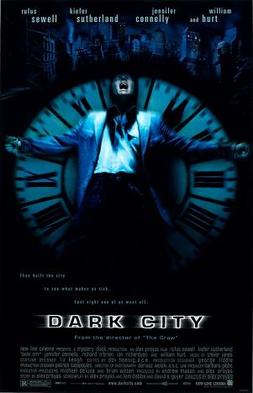(Dark City, 1998)
The style of German Expressionism can be conclude with the use of oblique camera angles, such as the scene that shows the protagonist's fingerprint with oblique camera angle. Other than that, distorted bodies and shapes are also the style of the German Expressionism, there are many scenes that show distorted bodies and shapes throughout the movie. For instance, when the strangers were tuning, the buildings in the scenes were twisting to change landscape. The effects during tuning and combat battle between the protagonist and the antagonist were one of the ways to present distortion. Another ways for the representation of distortion is the alien's look and movement of the antagonists. Moreover, bizarre and incongruous settings that are usually Gothic in look and framing, there is one scene that one of the family was imprinted by the strangers, the outfit and the environment of that family were changed and it is more to Gothic style. Furthermore, the style of the German Expressionism also consists of the high contrast (low-key) lighting that create dramatic shadows. For an example, the scene when the inspector went to visit his friend which is also an inspector once. The inspector was invited to the room that his friend scribbled on the wall, the room was dark and chiaroscuro lighting were shown by using only a kerosene lamp.
The German Expressionism has many kind of themes, such as revolt, self-analysis, madness and primitive, sexual savagery. The theme of revolt can clearly be seen in many scenes throughout the movie. One of the scene that the protagonist was fighting with the strangers by escaping and looking for the truth that distorted by the strangers shows the act of revolt. Another example was in the scene that the doctor was forced to imprint the memories of the antagonists into the protagonist's mind, but the act of revolt is shown with the doctor inject another syringe that contain everything that the protagonist wanted to know. Another obvious instance is when the time that the protagonist gain the power of tuning which is owned by the antagonists, the act of revolt is already begin.
Another theme of German Expressionism is the self-analysis. Throughout the whole film, we will be aware of that the protagonist is questioning himself about who he is,the one self and where they are, the environment. Another character that also keep on questioning himself was Mr Walenski, he found out that the strangers were imprinting the memories when he was still awake.
Madness is also one of the theme of German Expressionism that is applied in the film. The most representative character for this movie is Mr Walenski, a friend of the inspector. He had a room that is prohibited from his wife and he scribbled the symbol of the strangers all over the wall of that room. Finally, he killed himself by jumping into the train tracks so that he can relief from that world. Other than Mr Walenski, the protagonist is also a character that has madness in it. It can be observed with the scene the protagonist is obsessing with the Shell Beach as he asked everyone he know about how to reach to Shell Beach and at the end of the film the protagonist build up the Shell Beach. Furthermore, the protagonist killed all the strangers in the center of the system by only himself.
In this film, Surrealism is also consisted. The surreal contents that can be seen in the movie is the city is a fact of different eras on earth. As we can see in the movie, the outfits that are wore by the characters in the film is in Gothic style. Moreover, the city as a maze like it is in an experiment. For instance, the purpose of the antagonists imprint the human's memories and tune the city landscape are to learn how to be like a human as they are dying and sharing the same group of mind. Furthermore, chiaroscuro lighting that create dramatic shadows is used in some scenes. For example, when protagonist walked through the alley, toward to the Shell Beach, the shadows are dark enough to create the intense feeling. Another example for this is the scene that one of the antagonist emerges from the dark to ask protagonist when finally the protagonist controlled the city.
In a conclusion, Expressionism was displayed in literature, painting, theater and architecture of Scandinavian and German-speaking countries. It also spread into cinema in terms of narrative, set and mise-en-scene. It is very obvious to see when come into the set design and chiaroscuro lighting. German Expressionism is affected by the Expressionist movement in the modern art in early 1900s and it appeared as a film style during 1919 to 1926. An example that applied German Expressionism into the movie is named 'Dark City'.
References:
Plot Summary. (n.d.). Retrieved April 16, 2017, from http://www.imdb.com/title/tt0118929/plotsummary?ref_=tt_ql_stry_2
Darsa, A. (2015, March 16). An Introduction to German Expressionist Films. Retrieved April 16, 2017, from https://news.artnet.com/market/art-house-an-introduction-to-german-expressionist-films-32845






